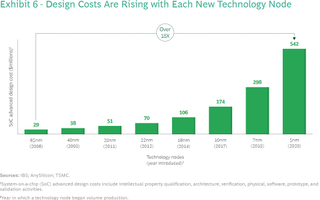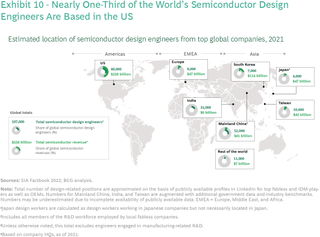Lobbying Group for U.S Semiconductor Industry: Government Assistance Necessary to Maintain Global Leadership
SIA report says U.S. needs public funding to stay ahead of the pack

The U.S. is the world's largest chip developer. But as semiconductors become more ubiquitous and important, other countries are gaining chip design prowess and market share.
If the U.S. wants to maintain its position as the world's largest chip developer, the U.S. government will have to help fund local semiconductor R&D according to a report from the Semiconductor Industry Association and Boston Consulting Group.
Chip Development Is Expensive
American companies control approximately 46% of the global semiconductor design-related revenue — about 2.5 times higher than the closest competitor. The U.S. is particularly strong with logic chips, such as CPUs, GPUs, and various other complex SoCs, as companies like AMD, Apple, Intel, Nvidia, and Qualcomm dominate the processor, graphics card, and mobile SoC markets.
But 46% is down — the U.S. controlled over 50% of the market in 2015, according to the SIA. This loss is because countries such as China, South Korea, and Taiwan have been gaining design-related share for years, thanks to federal- and local-government-supported semiconductor research and development activities, as well as domestic talent development. For example, in 2021 South Korea approved a $450 billion plan to develop local semiconductor industry over the next 10 years. That figure included $1.3 billion for AI and power chip design.
If nothing changes and the U.S. continues its current downward trajectory, the U.S. share of chip design revenue could drop to 36% by the end of the decade, according to the report.



As logic and memory chips get more complex, they require more R&D investments and more engineering talent. Design cost of a fairly complex chip to be produced at a 5nm class process technology — which includes design of both physical integrated circuits and associated software — is estimated to exceed $540 million, according to International Business Research. American companies produce dozens of such system-on-chips every year spending billions on design-related R&D. In 2021 alone companies from the U.S. poured in around $40 billion in chip design.
Analysts from the Semiconductor Industry Association estimate that the U.S. public sector is set to invest $400 billion to $500 billion over the next 10 years in R&D and workforce development. But they believe this is not enough to maintain chip design leadership for the whole country.
Stay on the Cutting Edge
Join the experts who read Tom's Hardware for the inside track on enthusiast PC tech news — and have for over 25 years. We'll send breaking news and in-depth reviews of CPUs, GPUs, AI, maker hardware and more straight to your inbox.

Experts from the SIA and BCG warn that the U.S. semiconductor design industry already faces a shortage of skilled workers — and by 2030 that shortage might increase to 23,000 as science, technology, engineering, and mathematics (STEM) graduates leave the industry.
Furthermore, things such as export restrictions for crème-de-la-crème processors for growing artificial intelligence and high-performance computing applications (e.g., AMD's Instinct MI250X, Intel's Ponte Vecchio, and Nvidia's A100 and H100 compute GPUs that sell for $10,000+ apiece) further threaten the ability of American companies to invest in R&D since such curbs limit their revenue growth.
Large OEMs Depend on Chips
Chip design prowess not only ensures the prosperity of American chip developers, it also ensures the success of adjacent original equipment manufacturers. In the U.S. this includes 34 world-class companies, including Apple, Dell, HP, and HPE. By contrast, there are 27 huge companies in China, including Huawei, Lenovo, BKK, and Xiaomi, that consume chips made in the People's Republic as well as elsewhere.
The Chinese government understands how important it is to develop chips domestically — even if they're produced elsewhere — and has been nuturing its local design industry for years. Earnings of the top 25 Chinese fabless companies doubled from $12.2 billion in 2017 to $24.4 billion in 2020, according to data from the SIA.
Public Sector Chip Development Funding Needed
The CHIPS & Science Act passed earlier this year involves $11 billion spending on various R&D projects focused on new semiconductor production methods (i.e., new fundamental manufacturing technologies), advanced semiconductor research (transistor structures, materials), metrology research, and innovative chip packaging.
But the act will not fund chip designers: while Micron and Western Digital will get some funding to conduct pre-competitive R&D for materials, transistors, manufacturing methods, analysis, and metrology, they will get nothing to design actual products that will compete against those developed elsewhere.

Developing actual products ahead of competition is dramatically important because it allows first movers to set new market standards that others have to follow. Companies that set their own standards also tend to directly benefit. For example, Nvidia's proprietary CUDA parallel computing platform and development environment is so far ahead of rivals that the company has enjoyed years of dominance in some AI and HPC sectors.
At present, around 13% of semiconductor design R&D in the U.S. is funded by public investments. Around 20% - 30% of such R&D is funded by governments, local authorities, or through tax incentives in Europe, Taiwan, South Korea, and Japan. In China, a whopping 45% of chip design-related R&D is funded using direct public funding (government, local authorities, public universities, etc.), tax incentives, and other initiatives.
To ensure U.S. leadership in chip design going forward, public sector investments are required, experts from the Semiconductor Industry Association and Boston Consulting Group believe.
The good news is that each public dollar invested in design and R&D would induce additional private-sector investments and therefore increase sales of actual chips significantly, according to the analysts.
They estimate that if the U.S. public sector invests $20 billion to $30 billion through 2030 in design and R&D (including a $15 billion to $20 billion design tax incentive), this would eventually generate design-related sales of around $450 billion over 10 years. It would also help train and employ 23,000 semiconductor design engineers and create 130,000 indirect jobs.
Summary
The U.S. still leads in advanced logic processors and other logic, but lags in memory, sensors, and optoelectronics. This is not going to change any time soon, but the chip design-related revenue share controlled by American companies may also drop in the coming years if the ongoing trends continue.
Industry experts believe public sector funding of chip design and R&D in Europe and Asia will allow non-U.S. companies to expand their chip design-related revenue share if the U.S. does not act.
Public investments in chip design R&D in the U.S. do not need to be extremely high, as the chip development ecosystem already exists — and there are dozens of competitive chip designers in the country.
The report from the SIA and BCG indicates that if the U.S. public sector invests $20 billion to $30 billion through 2030 in design and R&D (including tax incentives), this would fuel private sector investment and generate incremental design-related sales of around $450 billion over 10 years. This would be more than enough for the U.S. to maintain its position as the world's leading chip developer.

Anton Shilov is a Freelance News Writer at Tom’s Hardware US. Over the past couple of decades, he has covered everything from CPUs and GPUs to supercomputers and from modern process technologies and latest fab tools to high-tech industry trends.
-
btmedic04 Oh boy, lets all subsidize more mega corporations next round of lay offs, said no tax payer everReply -
ezst036 Here comes CHiPS 2.0. The wealthy want more corporate welfare, and who's opposed to that? The CHiPS 1.0 money grab was a smashing success.Reply
Next thing you know it will be CHiPS 3.0, 4.0, and all for the dear lovely lobbyists.
-
DavidLejdar What is also different in Europe though is that sales of i.e. electronics and digital goods get taxed (more). And that arguably isn't as consumer-friendly as in the U.S. But it means that there are tax funds to fund stuff, without expecting e.g. railroad workers to pay for it by not having paid sick days.Reply -
TechieTwo Corporate financial greed knows no limits. Export U.S. jobs and tech then beg for Mo Money while making record profits.Reply -
bigdragon The root problem is that corporations are compelled to grow where they can minimize expenses and maximize return for investors. Government handouts will never be enough, will not stop companies from outsourcing design engineering, and will cost increasing amounts as time goes on. The goal of every company is to get the public to take on its risk while the investors capture all the reward. Laws are needed to change this dynamic. CHIPS 2.0 would be an enormous mistake that doesn't address the root economic system problem.Reply -
hotaru251 ReplyIf the U.S. wants to maintain its position as the world's largest chip developer, the U.S. government will have to help fund local semiconductor R&D according to a report from the Semiconductor Industry Association and Boston Consulting Group.
just redirect it from the military budget then (as they also benefit from said chips).
or have em sell cookies/popcorn like the young girls/boys across nation :|
they'd just need laws made to discourage it.bigdragon said:will not stop companies from outsourcing
(they wont but its an option)
Most Popular


